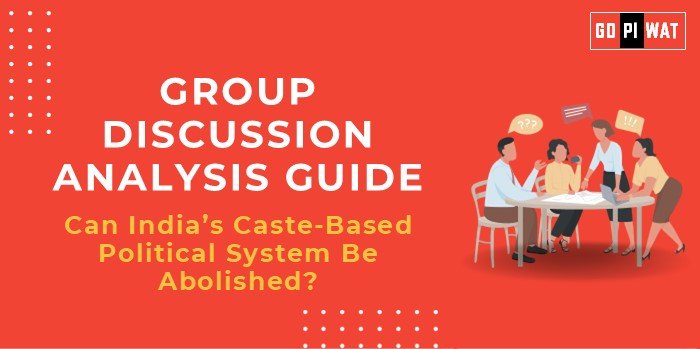📋 Group Discussion Analysis Guide: Can India’s Caste-Based Political System Be Abolished?
🌐 Introduction to the Topic
- 📖 Opening Context: India’s caste-based political system, rooted in its socio-political history, significantly influences electoral strategies and public policy. It raises questions about equity, representation, and modernization of governance.
- 🌍 Background: The caste system, an ancient social hierarchy, evolved into a political framework post-independence, cementing itself through reservations and political alliances. Abolishing this system demands balancing equity with the need for meritocracy and modernization.
📊 Quick Facts and Key Statistics
- ⚖️ Constitutional Reservations: 50% of public sector jobs and educational seats reserved for Scheduled Castes, Scheduled Tribes, and Other Backward Classes.
- 🏛️ Representation: 120+ reserved parliamentary constituencies ensure inclusivity in governance.
- 📊 Impact: Caste-based alliances influence over 50% of Indian elections (CSDS, 2023).
- 📈 Public Sentiment: 70% of urban Indians believe caste-based politics hampers meritocracy (Pew Research, 2023).
🤝 Stakeholders and Their Roles
- 🏛️ Government: Ensures equity through reservation policies; balances inclusivity and meritocracy.
- 🗳️ Political Parties: Leverage caste dynamics to mobilize voters.
- 👥 Citizens: Both beneficiaries of reservations and those demanding a merit-based system.
- ⚖️ Judiciary: Interprets constitutional provisions and limits on caste-based reservations.
- 📢 Social Organizations: Advocate for marginalized groups or promote anti-caste campaigns.
🏆 Achievements and Challenges
✨ Achievements:
- ✅ Representation: Marginalized groups hold significant political offices.
- 📈 Economic Progress: Reservation policies uplifted millions from poverty.
- 📢 Social Awareness: Movements like Dalit empowerment have reshaped public dialogue.
⚠️ Challenges:
- 📊 Polarization: Encourages vote-bank politics.
- 📉 Stagnation: Limited mobility for non-beneficiaries of the system.
- 🌏 International Benchmark: Countries like South Africa shifted from racial-based affirmative action to socio-economic models, offering possible alternatives.
💡 Structured Arguments for Discussion
- 📢 Supporting Stance: “Abolishing caste-based politics can enable meritocratic governance, aligning with India’s global ambitions.”
- ❌ Opposing Stance: “Caste-based politics ensures representation for marginalized communities, a necessity in a diverse society.”
- ⚖️ Balanced Perspective: “While caste-based policies have democratized opportunities, evolving toward economic and skill-based criteria might better address India’s future needs.”
📌 Effective Discussion Approaches
🎯 Opening Approaches:
- 📜 Historical Perspective: “India’s post-independence caste policies addressed systemic discrimination but created new challenges.”
- 📊 Data-Driven: “With 120+ reserved parliamentary constituencies, the system deeply influences governance.”
🔄 Counter-Argument Handling:
- 🌏 Reference countries transitioning to economic affirmative action models, such as South Africa.
- 📋 Advocate a phased approach to reforms, ensuring continued representation for marginalized groups.
📚 Strategic Analysis of Strengths and Weaknesses
- 💪 Strengths:
- 📢 Empowers marginalized groups.
- 🏛️ Increases political diversity.
- ❌ Weaknesses:
- 📉 Perpetuates identity politics.
- ⚖️ Reduces focus on meritocracy.
- ✨ Opportunities:
- 📋 Shift to socio-economic criteria.
- 🌟 Promote pan-Indian identity over caste divisions.
- ⚠️ Threats:
- 📢 Political resistance to change.
- 📉 Risk of disenfranchising vulnerable groups.
🎓 Connecting with B-School Applications
🌐 Real-World Applications:
- 📋 Case studies in political strategy and public policy reforms.
- 📊 Analyzing electoral behavior and its socio-economic impacts.
❓ Sample Interview Questions:
- ❓ “How can India balance caste representation with meritocracy?”
- 💡 “Should caste-based policies transition to economic criteria?”
📈 Insights for Students:
- 📖 Analyzing political systems through SWOT and PESTLE frameworks.
- 📊 Exploring affirmative action’s economic implications.


